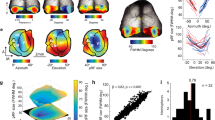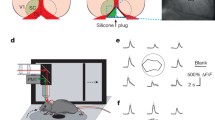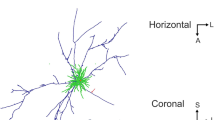Summary
-
1.
In the course of long oblique penetrations through the postlateral gyrus a variation in the position of the receptive fields (RF-scatter) of single cells recorded extracellularly is observed. This is superimposed on the continuous topological representation of the retina. Spezifying the RF-positions by the azimuthal and elevation coordinates of their geometrical centers, the standard deviation (SD) of the mean RF-positions of cells recorded in 200 μm long horizontal sections of cortex is calculated and the total radial scatter of RF-positions (Sanderson, 1971) as defined: \(\sqrt {\left( {{\text{4SD azimuth}}} \right)^2 + \left( {4SD{\text{ elevation}}} \right)^2 } \) is determined. The radial scatter is found to have its smallest value (1 degree visual angle (v.a.)) in the projection area of the functional center of the area centralis increasing to 3–4 degrees v.a. at 10 degrees eccentricity.
-
2.
The mean RF-diameter as defined: \(\sqrt {{\text{mean RF - area}}} \) is centrally 0.7 degrees v.a. increasing to 2.6 degrees v.a. at 10 degrees eccentricity. The ratio of the largest RF-diameter to the smallest RF-diameter is between 7–9 and remains almost constant over the central 10 degrees of the projection area. The magnification factor (M) as defined: mm Cortex/degree v.a. is centrally 2.3, decreasing paracentrally to 0.6.
-
3.
The cells in area 17 whose RFs have the same direction in the visual field constitute the spatial subunit of the retinocortical projection. The diameter of the spatial subunit is calculated as: \(\sqrt {\left( {{\text{total radical scatter}}} \right)^2 + \left( {{\text{average RF - diameter}}} \right)^2 } \). The spatial subunit functionally represents, therefore, that part of the visual field whose location and area is calculated by averaging over the RFs of the individuals of its cell population. It is found that the cells belonging to a spatial subunit are distributed within a cortical cylinder of 2.6–2.8 mm in diameter, the peak of the distribution coinciding with the central axis of the cylinder.
-
4.
Within the projection area of the central 10 degrees of the retina in area 17 the spatial subunits have the same diameter. This suggests that each retinal ganglion cell is functionally connected with an equal number of cells in area 17 irrespective of its position within the retina and that, therefore, the retinocortical projection is organized on the basis of a stereotyped schema if a basic spatial relationship is concerned.
Similar content being viewed by others
References
Albus, K.: Predominance of monocularly driven cells in the projection area of the central visual field in cat's striate cortex. Brain Res. 89, 341–347 (1975)
Albus, K.: A quantitative study of the projection area of the central and the paracentral visual field in area 17 of the cat. II. The spatial organization of the orientation domain. Exp. Brain Res. 24, 181–202 (1975)
Barlow, A.B., Blakemore, C., Pettigrew, J.D.: The neural mechanism of binocular depth discrimination. J. Physiol. (Lond.) 193, 327–342 (1967)
Berkley, M.A., Watkins, D.W.: Visual acuity of the cat estimated from evoked cerebral potentials. Nature, New Biol. 234, 91–92 (1971)
Bilge, M., Bingle, A., Seneviratne, K.N., Whitteridge, D.W.: A map of the visual cortex in the cat. J. Physiol. (Lond.) 191, 116 P (1967)
Bishop, P.O., Kozak, W., Vakkur, G.J.: Some quantitative aspects of the cats eye: axis and plane of reference, visual field coordinates and optics. J. Physiol. (Lond.) 163, 466–502 (1962a)
Bishop, P.O., Kozak, W., Levick, W.R., Vakkur, G.J.: The determination of the projection of the visual field on to the lateral geniculate nucleus in the cat. J. Physiol. (Lond.) 163, 503–539 (1962b)
Bisti, S., Maffei, L.: Behavioural contrast sensitivity of the cat in various visual meridians. J. Physiol. (Lond.) 241, 201–210 (1974)
Blake, R., Cool, S.J., Crawford, M.L.J.: Visual resolution in the cat. Vision Res. 14, 1211–1217 (1974)
Blakemore, C., Pettigrew, J.D.: Eye dominance in the visual cortex. Nature (Lond.) 225, 426–429 (1973)
Y Cajal, R.: Studien über die Sehrinde der Katze. J. Psychol. Neurol. (Lpz.) 29, 161–186 (1922)
Le Gros Clarke, W.E.: Observations on the assoziation fibre system of the visual cortex and the central representation of the retina. J. Anat. (Lond.) 75, 225–235 (1941)
Cowey, A.: Projection of the retina onto striate and parastriate cortex in squirrel monkey. J. Neurophysiol. 27, 366–393 (1964)
Creutzfeldt, O.D., Innocenti, G.M., Brooks, D.: Vertical organization in the visual cortex (area 17) of the cat. Exp. Brain Res. 21, 315–336 (1974)
Daniel, P.M., Whitteridge, D.W.: The representation of the visual field on the cerebral cortex of monkeys. J. Physiol. (Lond.) 159, 203–221 (1961)
Fernald, R., Chase, R.: An improved method for plotting retinal landmarks and focusing the eyes. Vision Res. 11, 95–96 (1971)
Fischer, B.: Overlap of receptive field centers and representation of the visual field in the cat's optic tract. Vision Res. 13, 2113–2121 (1973)
Hubel, D.H.: Single unit activity in lateral geniculate body and optic tract of unrestrained cats. J. Physiol. (Lond.) 150, 91–104 (1960)
Hubel, D.H., Wiesel, T.N.: Receptive fields, binocular interaction and functional architecture in the cat's visual cortex. J. Physiol. (Lond.) 160, 106–154 (1962)
Hubel, D.H., Wiesel, T.N.: Shape and arrangement of columns in the cat's striate cortex. J. Physiol. (Lond.) 165, 559–568 (1963)
Hubel, D.H., Wiesel, T.N.: Receptive fields and functional architecture of two nonstriate visual area (18 and 19) of the cat. J. Neurophysiol. 28, 229–289 (1965)
Hubel, D.H., Wiesel, T.N.: Receptive fields and functional architecture of monkey striate cortex. J. Physiol. (Lond.) 195, 215–243 (1968)
Hubel, D.H., Wiesel, T.N.: A re-examination of stereoscopic mechanisms in area 17 of the cat. J. Physiol. (Lond.) 232, 29–30 P (1973)
Hubel, D.H., Wiesel, T.N.: Uniformity of monkey striate cortex: A parallel relationship between field size, scatter, and magnification factor. J. comp. Neurol. 158, 295–306 (1974)
Hubel, D.H., Wiesel, T.N.: Visual field representation in layer IVC of monkey striate cortex. American Soc. Neuroscience, 4th Ann. Meet. 311, (1974)
Leicester, J.: Projection of the visual vertical meridian to cerebral cortex of cat. J. Neurophysiol. 31, 371–382 (1968)
Marshal, W.H., Talbot, S.A.: Recent evidence for neural mechanisms in vision leading to a general theory of sensory acuity. In: Biological symposia. (Cattell, J., Ed.), Vol. VII, Visual mechanism, (Klüver, H., Ed.), p. 117–164. New York: Ronald Press 1942
Nikara, T., Bishop, P.O., Pettigrew, J.D.: Analysis of retinal correspondence by studying receptive fields of binocular single units in cat striate cortex. Exp. Brain Res. 6, 353–372 (1968)
Lorente de Nó, R.: Studies on the structure of the cerebral cortex. II. Continuation of the study of the ammonic system. J. Psychol. Neurol. (Lpz.) 46, 113–177 (1934)
Mountcastle, V.B.: Modality and topographic properties of single neurons of cat's somatic sensory cortex. J. Neurophysiol. 20, 408–434 (1957)
O'Leary, J.: Structure of the area striata of the cat. J. comp. Neurol. 75, 131–164 (1941)
Otsuka, R., Hassler, R.: Über Aufbau und Gliederung der corticalen Sehsphäre bei der Katze. Arch. Psychiat. Neurol. 203, 212–234 (1962)
Poljak, S.: The vertebrate visual system. p. 510–539. Chicago: University of Chicago Press 1957
Rodieck, R.W., Pettigrew, J.D., Bishop, P.O., Nikara, T.: Residual eye movements in receptive field studies of paralyzed cats. Vision Res. 7, 107–110 (1967)
Sanderson, K.J.: Visual field projection columns and magnification factors in the lateral geniculate body of the cat. Exp. Brain Res. 13, 159–177 (1971)
Sholl, D.A.: The organization of the visual cortex in the cat. J. Anat. (Lond.) 89, 33–46 (1955)
Smith, J.: Visual discrimination in the cat. IV. The visual acuity of the cat in relation to stimulus distance. J. genet. Psychol. 49, 297–313 (1936)
Stone, J., Hansen, S.M.: The projection of the cat's retina on the lateral geniculate nucleus. J. comp. Neurol. 126, 601–624 (1966)
Weiskrantz, L.: Behavioural analysis of the monkey's visual nervous system. Proc. roy. Soc. B 182, 427–455 (1972)
Wilson, J.R., Sherman, S.M.: Receptive fields characteristics in cat striate cortex: changes with visual field eccentricity. Amer. Soc. Neuroscience, 4th Ann. Meet, 743 (1974)
Author information
Authors and Affiliations
Additional information
A preliminary report has been presented at the German Physiological Society Meeting, Spring 1973, Pflügers Arch. ges. Physiol. 339, R 91 (1973).
Rights and permissions
About this article
Cite this article
Albus, K. A quantitative study of the projection area of the central and the paracentral visual field in area 17 of the cat. Exp Brain Res 24, 159–179 (1975). https://doi.org/10.1007/BF00234061
Received:
Issue Date:
DOI: https://doi.org/10.1007/BF00234061




